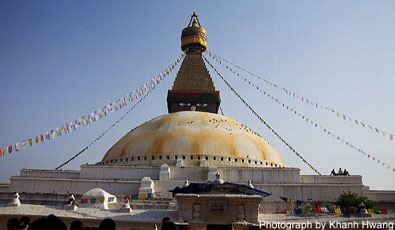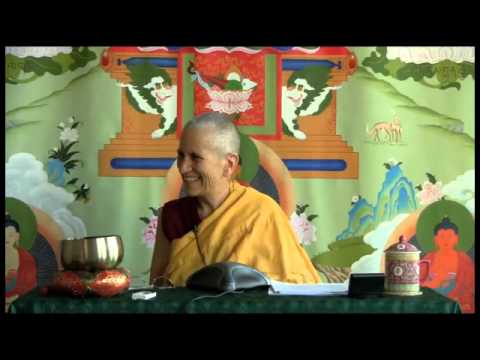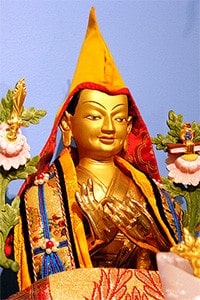The extensive offering practice
The extensive offering practice

This text was composed by Lama Zopa Rinpoche and edited by Venerable Thubten Chodron. Printed with permission from Lama Yeshe Wisdom Archives.
Preliminary
Make offerings on your altar. Do Meditation on the Buddha or Lama Tsongkhapa Guru Yoga, inserting the extensive offering practice just before the offering verse.
Generate your motivation:
To attain enlightenment in order to benefit all my kind mother sentient beings, I will make these extensive offerings on behalf of all sentient beings.
Or, think that you and all sentient beings make offerings together.
The Buddha or Lama Tsongkhapa is the central figure in the field of positive potential. He is surrounded by all the Buddhas and bodhisattvas. All of them are emanations of the transcendental wisdom of bliss and emptiness and are the nature of your root spiritual mentor and the deity. They have the same essence of blissful, compassionate wisdom, but are given different labels because they appear in different forms.
You appear as the deity in the nature of great bliss non-dual with emptiness. Think that each offering—water bowls, flowers, incense, lights, perfume, food, music, and so forth, actual offering substances as well as those you visualize—is in the nature of great bliss non-dual with emptiness. By thinking that the nature of the offerings is great bliss, it is easy to feel that they generate infinite bliss in the holy minds of each figure in the field of positive potential. You also create more positive potential by offering pure substances.
Bless the offerings on the altar as well as other offerings such as your flower garden, forests, parks, lakes, meadows, and lights—candlelight, electric lights, and the light of the sun and moon—and transform them into the nature of great bliss and emptiness.
Bless and offer the offerings:
Recite the following dharani to bless and offer the offerings:
Om namo bhagavate bendzay sarwaparma dana tathagataya arhate samyaksam buddhaya tayata om bendzay bendzay maha bendzay maha taydza bendzay maha bidya bendzay maha bodhicitta bendzay maha bodhi mendo pasam kramana bendzay sarwa karma awarana bisho dana bendzay soha (3x)
Recite the prayer of the power of the truth:
By the power of the truth of the Three Jewels, the power of the inspiration of all the Buddhas and bodhisattvas, the power of the great might of the completed two collections, and the power of the intrinsically pure and inconceivable sphere of reality, may (these offerings) become suchness.
Visualize the countless Buddhas in the ten directions receiving clouds of offerings. Think that the Buddhas are the embodiment of your spiritual mentor and the deity that you practice. Offer the offerings placed on your altar as well as skies filled with beautiful offerings. Think that you generate infinite bliss in their holy minds by making these offerings.
Sentient beings experience difficulties because they lack positive potential, which they need to be successful and happy. By thinking that we give sentient beings things to offer to the Three Jewels and by making offerings on their behalf, we create positive potential and dedicate it for their benefit. This is similar to how the Buddha dedicated positive potential towards all sentient beings.
Now make charity of all these offerings to sentient beings. Give them to each hell being, hungry ghost, animal, human being, demi-god, god, intermediate state being, arhat, and bodhisattva. In this way, the people starving to death, those who are homeless or unable to find a job, who have a very hard life—they all receive these offerings to give to the Three jewels.
While making offerings, put your palms together so that you bow to them at the same time. Think that each pore of each figure in the field of positive potential is itself a complete field of positive potential. Visualizing in this way, make offerings to these holy beings.
Actual offering
Offer these extensive offerings to all your spiritual mentors and to all the holy objects in this country, and generate great bliss in their holy minds. Visualize giving them these spectacular offerings many times.
Next offer all these nectars, flowers, lights and so forth to His Holiness the Dalai Lama, other spiritual mentors in India, and to all the holy objects in India, including in Bodhgaya where 1,000 Buddhas will descend. Offer to them many times, not just once.
Offer to all the holy beings and holy objects in Tibet, including the Shakyamuni Buddha statue in the Lhasa Temple. Remember to think of them as the nature of great bliss and emptiness, the nature of your root spiritual mentor and the deity. Offer to them many times, generating great bliss in their minds.
Make offerings to your spiritual mentors, holy beings, and holy objects in Nepal, especially the most precious stupa at Bodhanath. Think of them as above and offer to them many times.
Offer these pure offerings to all your spiritual mentors, holy beings, and holy objects in all other Buddhist countries: Thailand, Sri Lanka, Burma, Taiwan, China, and so forth.
Now offer to your spiritual mentors, holy beings, and holy objects in Western countries and in the rest of the world.
Make offerings to each and every Buddha, bodhisattva, arhat, statue, stupa, and scripture in the ten directions—to the Three Jewels—in this universe and beyond. By making offerings in this way, every time somebody makes more tsa-tsas, thangkas, statues, pictures or photos of Buddhas, you create much more positive potential. Offer as many times as possible by thinking of them as the nature of great bliss and emptiness, the nature of your root spiritual mentor and the deity, and generate infinite bliss in their holy minds.
Recite the offering verses one, three, or seven times:
These actually performed and mentally imagined water bowl offerings, the manifestations of my own innate wisdom awareness, dharmakaya, these clouds of offerings equaling the infinite sky, I offer to all my spiritual mentors and the Three Jewels, and to the statues, stupas, and scriptures, which are their manifestations.
Due to this positive potential, may whomever I promised to pray for and whoever prays for me—principally friends, benefactors and disciples—as well as all sentient beings living and dead, may the rays of the light of the five wisdoms completely purify all their degenerated vows and commitments right now.
May the sufferings of the lower realms be ceased right now. May all the three realms of samsara be empty right now. May all impure minds and their obscurations be purified. May all appearances be purified. May the five holy bodies and wisdom spontaneously arise.
Dedication
Complete Meditation on the Buddha or Lama Tsongkhapa Guru Yoga, and then dedicate:
Due to having made these extensive offerings to all holy beings and holy objects, may I, my family members, and all the students and benefactors, especially those who dedicate their lives for others and those who offer service at this abbey, monastery, or Dharma center, and all other sentient beings be able to actualize completely the pure teachings of the Buddha and of Lama Tsongkhapa. May we live in pure morality and courageously engage in extensive bodhisattva deeds and the yoga of the two stages, in order to actualize the transcendental wisdom of non-dual bliss and emptiness.
Kyabje Lama Zopa Rinpoche
Kyabje Lama Zopa Rinpoche, one of Venerable Chodron's teachers, was born in Thami, Nepal, in 1946. At the age of three he was recognized as the reincarnation of Sherpa Nyingma yogi, Kunsang Yeshe, the Lawudo Lama. Rinpoche’s Thami home was not far from the Lawudo cave, in the Mount Everest region of Nepal, where his predecessor meditated for the last twenty years of his life. Rinpoche’s own description of his early years may be found in his book, The Door to Satisfaction (Wisdom Publications). At the age of ten, Rinpoche went to Tibet and studied and meditated at Domo Geshe Rinpoche’s monastery near Pagri, until the Chinese occupation of Tibet in 1959 forced him to forsake Tibet for the safety of Bhutan. Rinpoche then went to the Tibetan refugee camp at Buxa Duar, West Bengal, India, where he met Lama Yeshe, who became his closest teacher. The Lamas went to Nepal in 1967, and over the next few years built Kopan and Lawudo Monasteries. In 1971, Rinpoche gave the first of his famous annual lam-rim retreat courses, which continue at Kopan to this day. In 1974, with Lama Yeshe, Rinpoche began traveling the world to teach and establish centers of Dharma. When Lama Yeshe passed away in 1984, Rinpoche took over as spiritual director of the Foundation for the Preservation of the Mahayana Tradition (FPMT), which has continued to flourish under his peerless leadership. More details of Rinpoche’s life and work may be found on the FPMT web site. (Source: lamayeshe.com. Photo by Aikido.)


